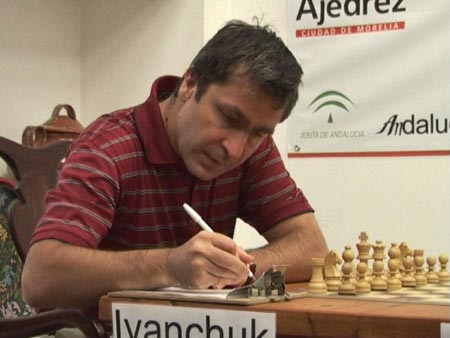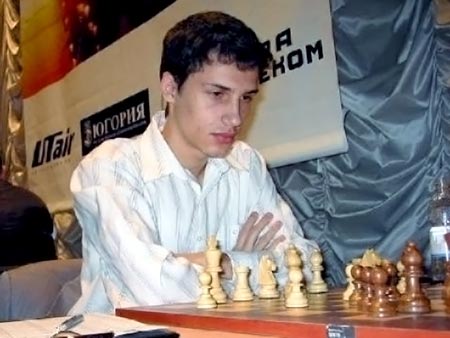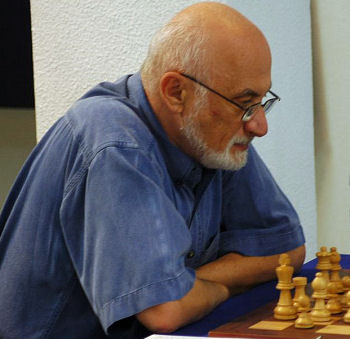| Latest | Greatest | Lobby | Journals | Search | Options | Help | Login |
|
|
|
This topic is archived. |
| Home » Discuss » Topic Forums » Sports |
|
| Jack Rabbit
|
Sun May-18-08 12:37 PM Original message |
| The Jack Rabbit Chess Report (May 18): Ivanchuk wins play outstanding chess in Sofia |
|
Edited on Sun May-18-08 12:40 PM by Jack Rabbit
Chukie takes MTel by a point and a half
 Ukrainian grandmaster Vassily Ivanchuk, known as Chuckie to his fans, won the fourth annual MTel Masters Tournament in the Bulgarian capital of Sofia today after his Black victory over Bulgarian GM Ivan Cheparinov in 33 moves. Ivanchuk scored a total of eight points (six wins and four draws) in ten rounds to take first prize by a point and a half over his nearest rival, former FIDE world champion Veselin Topalov. After winning the first five games of the event, Ivanchuk settled in and drew his next four during which time Topalov came within a half point of the lead. However, Topalov lost his ninth round game to Chinese grandmaster Bu Xiangzhi. This allowed Ivanchuk to enter today's final round needing only to avoid loss to win the tournament clear. Ivanchuk's game today was a real cliffhanger. He forced checkmate against Cheparinov, who was himself only a move away from checkmating Ivanchuk. !""""""""# $tWt+ L +% $+ +r+oOq% $o+m+o+ +% $+m+ V O % $ O + + +% $+ +bBp+ % $p+p+ + P% $K N + + % /(((((((() WHITE: Ivan Cheparinov Final Position after 33...Nc3b5+ In this position with White to move, if 34.Kb1 then Black replies 34...Na3#. White's only other legal move is 34.Bd4, postponing mate by one move. If White were not in check in the diagrammed position, he would checkmate Black with 34.Qh8#. Azerbaijani grandmaster Teimour Radjobov finish third with 5� points. Topalov, who finished second with 6� points, won a clear first in each of the first three editions of the MTel Masters. US Championships continue in Tulsa; 6th round today  Grandmasters Yury Shulman and Sergey Kudrin lead the general competition of the US Championships with 4 points each after five rounds in Tulsa, Oklahoma, while IMs Irina Krush and Anna Zatonskih have perfect scores in the women's competition. Shulman and Kudrin are followed by GMs Julio Becerra and 2006 US champion Alex Onischuk at 3� points apiece, while seven players, including defending champion Alex Shabalov, are at 3 points each. Ms. Krush, the efending women's champion, and Ms. Zatonskih, the 2006 champion, are leaving the rest of the field in the dust. Kat Rohonyan is in third place with 3� points. The final round will be played Wednesday, May 21. Play will begin each day at 2:30 pm CDT. Games will be broadcast live on the official tournament website hosted by Monroi.com. |
| Printer Friendly | Permalink | | Top |
| Jack Rabbit
|
Sun May-18-08 12:38 PM Response to Original message |
| 1. Games from Sofia |
|
Diagrams on the Jack Rabbit Chess Report are made with Chess M�rida, a true type font that can be downlaoded free here. !""""""""# $tMvWlVmT% $OoOoOoOo% $ + + + +% $+ + + + % $ + + + +% $+ + + + % $pPpPpPpP% $RnBqKbNr% /(((((((() WHITE White to move (This position is a theoretical draw) |
| Printer Friendly | Permalink | | Top |
| Jack Rabbit
|
Sun May-18-08 12:42 PM Response to Reply #1 |
| 3. Aronian - Ivanchuk, Round 5 |
|
Edited on Sun May-18-08 12:42 PM by Jack Rabbit
 Vassily Ivanchuk Levon Aronian - Vassily Ivanchuk MTel Masters, Round 5 Sofia, 12 May 2008 Slav Queen's Gambit: Tikhi Defense 1.d4 d5 2.c4 c6 3.Nf3 Nf6 4.e3 Bf5 5.Nc3 e6 6.Nh4 Bg6 7.Nxg6 hxg6 8.a3
8...Nbd7 9.g3 Be7 10.b3
10...e5 11.cxd5
11...Nxd5 12.Nxd5 Qa5+ 13.Nc3 Qxc3+ 14.Bd2 Qb2 15.d5!?
15...cxd5 16.Bb5 a6 17.Bxd7+ Kxd7 18.0-0
18...e4 19.Bc3??
19...Qxc3
20.Qxd5+ Ke8 21.Rac1 Qd3 22.Qxb7 Rd8 23.Rfd1
!""""""""# $ + Tl+ T% $+q+ VoO % $o+ + +o+% $+ + + + % $ + +o+ +% $Pp+wP P % $ + + P P% $+ Rr+ K % /(((((((() WHITE: Levon Aronian Position after 23.Rf1d1 23...Qxd1+!!
24.Rxd1 Rxd1+
25.Kg2 a5 26.g4 Kf8 27.Qxe4 g5
28.Qf5 Bd8 29.Qc5+ Kg8 30.Qe5 g6 31.b4 axb4 32.axb4 !""""""""# $ + V +lT% $+ + +o+ % $ + + +o+% $+ + Q O % $ P + +p+% $+ + P + % $ + + PkP% $+ +t+ + % /(((((((() WHITE: Levon Aronian Position after 32.ab4:p 32...Kh7!
33.b5 Rf8 34.Qc5 Kg8 35.b6
35...Rb1 36.f4 Rb2+ 37.Kg3 gxf4+ 38.exf4 Bxb6
39.Qc3 Rb1 40.f5 Rg1+ 41.Kh3 Re8 42.Qf6
42...Bf2
43.Qg7+ Kxg7 44.f6+ Kf8 0-1
|
| Printer Friendly | Permalink | | Top |
| Jack Rabbit
|
Sun May-18-08 12:52 PM Response to Reply #1 |
| 4. Cheparinov - Topalov, Round 3 |
 Veselin Topalov Ivan Cheparinov - Veselin Topalov MTel Masters, Round 3 Sofia, 10 May 2008 Closed French Game: Steinitz Opening 1.e4 e6 2.d4 d5 3.Nc3 Nf6 4.e5 Nfd7 5.f4 c5 6.Nf3
6...Nc6 7.Be3 a6
8.Ne2
8...Be7!?
9.c3
9...0-0 10.g3 cxd4!?
11.Nexd4
11...Nc5 12.Bg2
12...Bd7 13.0-0 Rc8 14.Kh1?!
14...Ne4 15.Nxc6
15...bxc6 16.c4 a5 17.Qc2
17...g6?!
18.Rad1 Nc5 19.Nd4 Qc7 20.g4
20...Rfd8 21.Qf2?!
21...Be8
22.f5
22...Qxe5 23.fxe6
23...Nxe6 24.Nxe6 Qxe6 25.Rde1?
!""""""""# $ +tTv+l+% $+ + Vo+o% $ +o+w+o+% $O +o+ + % $ +p+ +p+% $+ + B + % $pP + QbP% $+ + Rr+k% /(((((((() WHITE: Ivan Cheparinov Position after 25.Rd1e1 25...Qxg4!
26.Bd4 Qh4 27.Rxe7
27...Qxe7 28.Re1 Qg5 29.Re5 Qc1+
30.Re1 Qg5 31.Re5 f5!
32.h4
32...Qg4 33.Kh2
33...dxc4 34.Bh3 Qd1 35.Re1
!""""""""# $ +tTv+l+% $+ + + +o% $ +o+ +o+% $O + +o+ % $ +oB + P% $+ + + +b% $pP + Q K% $+ +wR + % /(((((((() WHITE: Ivan Cheparinov Position after 35.Re5e1 35...Rxd4!!
36.Rxd1 Rxd1 37.Bf1 Bf7 38.Be2 0-1
|
| Printer Friendly | Permalink | | Top |
| Jack Rabbit
|
Sun May-18-08 12:54 PM Response to Reply #1 |
| 5. Bu Xiangzhi - Cheparinov, Round 6 |
 Ivan Cheparinov Bu Xiangzhi - Ivan Cheparinov MTel Masters, Round 6 Sofia, 14 May 2008 Semi-Slav Queen's Gambit 1.c4 e6 2.Nc3 d5 3.d4 c6 4.e3 Nf6 5.b3
5...Nbd7 6.Bb2 Bd6 7.Nf3 0-0 8.Be2
8...Ne4
9.Nd2
9...f5 10.0-0 Qh4
11.f4 Nxd2 12.Qxd2 Nf6 13.a4!?
13...Rf7
14.a5 g5
15.g3 Qh3
16.Bf3
16...gxf4
17.exf4 Bd7
18.Na4 Ne4
19.Bxe4!
19...fxe4 20.Nc5 Be8 21.Ba3
21...Qf5 22.a6 b6 23.Nb7
23...Bxa3 24.Rxa3 Rg7
25.Nd6 Qf6
26.f5 Bh5
27.fxe6 Bf3 28.cxd5 cxd5 29.Nf7 h5
30.Ne5 h4 31.Nxf3 !""""""""# $t+ + +k+% $O + + T % $pO +pW +% $+ +o+ + % $ + Po+ O% $Rp+ +nP % $ + Q + P% $+ + +rK % /(((((((() WHITE: Bu Xiangzhi Position after 31.Ne5f3:B 31...hxg3!
32.b4
32...Rf8?!
33.h3?!
33...g2 34.Re1?
34...exf3!
35.Qf2 Qf5 36.Kh2
36...Qf4+ 37.Kg1 Qf5 38.Kh2 Qf4+
39.Kg1 Rg3 40.e7
!""""""""# $ + + Tl+% $O + P + % $pO + + +% $+ +o+ + % $ P P W +% $R + +oTp% $ + + Qo+% $+ + R K % /(((((((() WHITE: Bu Xiangzhi Position after 40.e6e7 40...Rxh3!!
41.exf8Q+ Kxf8 42.Rxf3 Rxf3 43.Re2 Kf7 44.b5 Kf6 0-1
|
| Printer Friendly | Permalink | | Top |
| Jack Rabbit
|
Sun May-18-08 12:39 PM Response to Original message |
| 2. Games fro Tulsa |
|
Diagrams on the Jack Rabbit Chess Report are made with Chess M�rida, a true type font that can be downlaoded free here. !""""""""# $tMvWlVmT% $OoOoOoOo% $ + + + +% $+ + + + % $ + + + +% $+ + + + % $pPpPpPpP% $RnBqKbNr% /(((((((() WHITE White to move (This position is a theoretical draw) |
| Printer Friendly | Permalink | | Top |
| Jack Rabbit
|
Sun May-18-08 12:56 PM Response to Reply #2 |
| 6. Gulko - Kaufman, Round 1 |
|
Boris Gulko is the only person to win both the Soviet and US chess championships.
 Boris Gulko Boris Gulko - Larry Kaufman US Championships (Genaral Competition), Round 1 Tulsa, 13 May 2008 West India Game: Indian Queen's Gambit (Stockholm Opening) (Gr�nfeld Defense) 1.c4 Nf6 2.d4 g6 3.Nc3 d5 4.Bg5 Ne4 5.Bh4
5...Nxc3 6.bxc3 dxc4 7.Qa4+
7...Qd7 8.Qxc4 Bg7 9.e3 b6 10.Qb3 Bb7!?
11.Nf3 0-0 12.Be2 c5 13.0-0 Nc6
14.Rfd1
14...cxd4 15.cxd4 Rac8 16.Rac1 e5?
17.dxe5!
17...Qf5
!""""""""# $ +t+ Tl+% $Ov+ +oVo% $ Om+ +o+% $+ + Pw+ % $ + + + B% $+q+ Pn+ % $p+ +bPpP% $+ Rr+ K % /(((((((() WHITE: Boris Gulko Position after 17...Qd7f5 18.Bd3!
18...Qh5 19.e6 Na5
20.exf7+ Kh8 21.Rxc8 Bxc8
22.Qc2 Bg4 23.Be7 Rxf7
!""""""""# $ + + + L% $O + BtVo% $ O + +o+% $M + + +w% $ + + +v+% $+ +bPn+ % $p+q+ PpP% $+ +r+ K % /(((((((() WHITE: Boris Gulko Position after 23...Rf8f7:p 24.Bc4!!
24...Nxc4 25.Rd8+ Bf8 26.Bxf8 Rxf8 27.Rxf8+ Kg7 28.Rf4 b5
29.Qc3+ Kh6 30.Rf7 Bxf3
31.Qg7+ Kg5 32.Rxf3 1-0
|
| Printer Friendly | Permalink | | Top |
| Jack Rabbit
|
Sun May-18-08 12:58 PM Response to Reply #2 |
| 7. Becerra - Fedorowicz, Round 2 |
|
Edited on Sun May-18-08 12:59 PM by Jack Rabbit
 Julio Becerra Julio Becerra - John Fedorowicz US Championships (General Competition), Round 2 Tulsa, 14 May 2008 Open Sicilian Game: Taimanov Defense 1.e4 c5 2.Nf3 Nc6 3.d4 cxd4 4.Nxd4 e6 5.Nc3
5...Qc7 6.Be3 a6 7.Bd3
7...Nf6 8.0-0 Ne5 9.f4
9...Neg4 10.Bd2 Bc5 11.Nce2 e5
12.fxe5 Qxe5?!
!""""""""# $t+v+l+ T% $+o+o+oOo% $o+ + M +% $+ V W + % $ + Np+m+% $+ +b+ + % $pPpBn+pP% $R +q+rK % /(((((((() WHITE: Julio Becerra Position after 12...Qc7e5:p 13.Bf4!!
13...Bxd4+ 14.Kh1!
14...Qc5
15.Nxd4 Qxd4?
16.e5!!
16...Nf2+ 17.Rxf2 Qxf2 18.exf6!
18...d6
19.Qe1+ Qxe1+ 20.Rxe1+ Be6 21.fxg7 Rg8 22.Bh6 Kd7
23.Bxh7 Rge8
24.Bg5 Bxa2 25.Rxe8 Rxe8 26.h4 f6
27.Bxf6 Bg8 28.Bf5+ 1-0
|
| Printer Friendly | Permalink | | Top |
| Jack Rabbit
|
Sun May-18-08 01:00 PM Response to Reply #2 |
| 8. Tuvshingtugs - Krush, Round 3 |
 Irina Krush Chimi Tuvshintugs - Irina Krush US Championships (Women's Competition), Round 3 Tulsa, 15 May 2008 Open Sicilian Game: O'Kelly Defense 1.e4 c5 2.Nf3 a6
3.c4 Nc6 4.d4 cxd4 5.Nxd4 e5
6.Nf5
6...d6 7.Bd3
7...g6 8.Ne3 Nf6
9.Nc3 Bg7 10.Ned5
10...Nxd5 11.Nxd5 0-0 12.h4
12...h5 13.Bg5 f6 14.Be3 Be6 15.Bb6!?
15...Qd7 16.Nc7
16...Rac8 17.Nxe6 Qxe6 18.0-0
18...Kh7 19.a3 Ne7 20.Be3 Bh6 21.b3
21...Bxe3 22.fxe3 Ng8 23.Ra2
23...Nh6 24.Be2 f5 25.Qd3
25...Rf6
26.Bd1
26...Rcf8 27.Raf2 f4 28.Qd5
28...Qxd5 29.cxd5 Kg7
30.Rc2 R6f7 31.Bf3?!
31...Ng4 32.Bxg4 hxg4 33.Rcf2?
!""""""""# $ + + T +% $+o+ +tL % $o+ O +o+% $+ +pO + % $ + +pOoP% $Pp+ P + % $ + + Rp+% $+ + +rK % /(((((((() WHITE: Chimi Tuvshintugs Position after 33.Rc2f2 33...g3!
34.Re2 Kh6 35.Rf3 Re8 36.Re1 Kh5 37.Kf1
37...Kxh4 38.Ke2 g5 39.Rh1+ Kg4 40.Rh6 Rc7 41.exf4
41...Rc2+ 42.Kf1 exf4 43.Re6 Rh8 0-1
|
| Printer Friendly | Permalink | | Top |
| Jack Rabbit
|
Sun May-18-08 01:04 PM Response to Reply #2 |
| 9. Epstein - Tuvshingtugs, Round 1 |
|
Note: This is the Game of the Day for May 18 (today) on ChessGames.com, a really cool website which I highly recommend.
 Chimi Tuvshingtugs Esther Epstein - Chimi Tuvshintugs US Championships (Women's Competition), Round 1 Tulsa, 13 May 2008 Royal Sardinian Game: Saragossa Opening (Vukovic Gambit) (Ponziani Opening) 1.e4 e5 2.Nf3 Nc6 3.c3
3...Nf6
4.d4 Nxe4 5.d5 Bc5
6.dxc6 Bxf2+
7.Ke2 Bb6!?
8.Qd5
8...Nf2 9.Bg5?
9...f6!
10.Nxe5
10...Qe7
11.cxd7+ Bxd7 12.Qxd7+
12...Qxd7 13.Nxd7 Kxd7 14.Be3 Rae8 15.Kxf2 Rxe3
!""""""""# $ + + + T% $OoOl+ Oo% $ V + O +% $+ + + + % $ + + + +% $+ P T + % $pP + KpP% $Rn+ +b+r% /(((((((() WHITE: Esther Epstein Position after 15...Re8e3:B 16.g3 Rxc3+ 17.Ke2 Rc2+ 18.Kd3 Rxb2
19.Bh3+
19...Ke7 20.Re1+ Kf7 21.Be6+ Kg6 22.Nc3 Rd8+?
23.Nd5 Rb5 24.Ke4 Re8?
25.Kf3 Ba5 26.Reb1?
26...Rc5 27.Rxb7 Kh6 28.Bd7
28...Rd8 29.Be6 Re8 30.Bd7 Re5
31.Nf4 Rc3+ 32.Kg4 g5 33.Rxa7 gxf4 34.gxf4 Rh5
35.Rh1?
!""""""""# $ + + + +% $R Ob+ +o% $ + + O L% $V + + +t% $ + + Pk+% $+ T + + % $p+ + + P% $+ + + +r% /(((((((() WHITE: Esther Epstein Position after 35.Ra1h1 35...Bb6!
36.Ra8 Rch3 37.Rf8 f5+ 0-1
|
| Printer Friendly | Permalink | | Top |
| Jack Rabbit
|
Sun May-18-08 07:59 PM Response to Original message |
| 10. Sunday afternoon update from Tulsa |
|
Yury Shulman, originally from Soviet Belarus and now living in Chicago, took a one-point lead over his nearest rival in the general competition of the US chess championship in Tulsa, Oklahoma, by defeating Sergei Kudrin in 51 moves.
In the other top game in the general competition, Julio Becerra former champion Alex Onischuk played 26 moves to a draw. Shulman has 5 points in six rounds while Kudrin, Becerra and Onischuk are tied for second for 4 points each. In the women's competition, former women's champion Anna Zatonskih defeated Esther Epstein in 68 moves today to take sole possession of first place. Defending women's champion Irina Krush, who entered today's sixth round tied for first, drew her game with Iryna Zenyuk to fall a half point behind Ms. Zatonskih. |
| Printer Friendly | Permalink | | Top |
| DU
AdBot (1000+ posts) |
Thu Apr 18th 2024, 03:42 PM Response to Original message |
| Advertisements [?] |
| Top |
| Home » Discuss » Topic Forums » Sports |
|
Powered by DCForum+ Version 1.1 Copyright 1997-2002 DCScripts.com
Software has been extensively modified by the DU administrators
Important Notices: By participating on this discussion board, visitors agree to abide by the rules outlined on our Rules page. Messages posted on the Democratic Underground Discussion Forums are the opinions of the individuals who post them, and do not necessarily represent the opinions of Democratic Underground, LLC.
Home | Discussion Forums | Journals | Store | Donate
About DU | Contact Us | Privacy Policy
Got a message for Democratic Underground? Click here to send us a message.
© 2001 - 2011 Democratic Underground, LLC